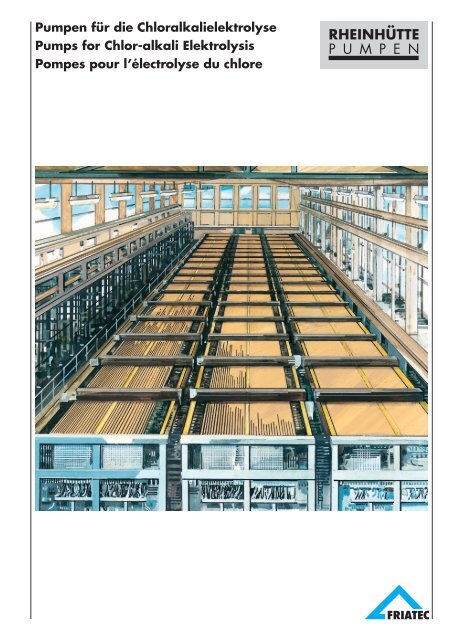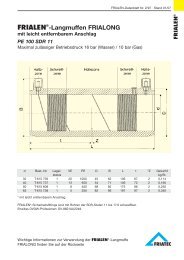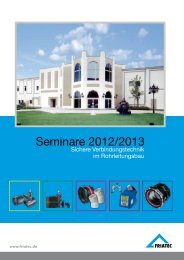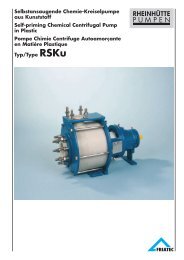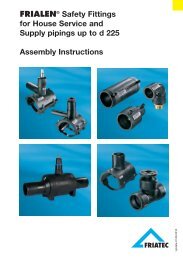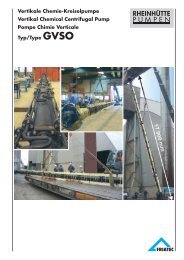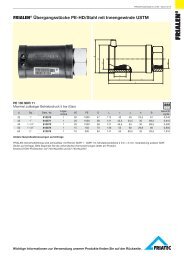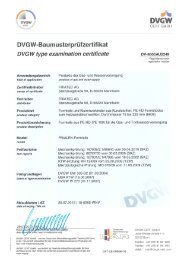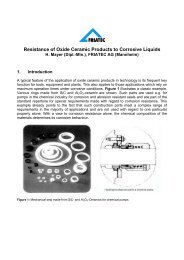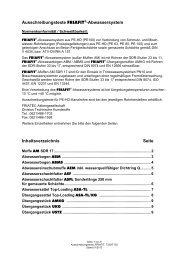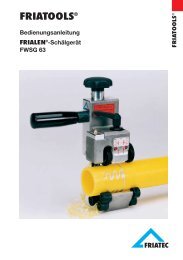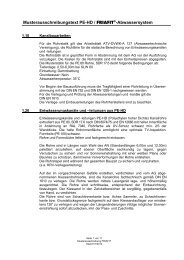Die Verfahren der Chloralkalielektrolyse The process of chlor-alkali ...
Die Verfahren der Chloralkalielektrolyse The process of chlor-alkali ...
Die Verfahren der Chloralkalielektrolyse The process of chlor-alkali ...
You also want an ePaper? Increase the reach of your titles
YUMPU automatically turns print PDFs into web optimized ePapers that Google loves.
Pumpen für die <strong>Chlor<strong>alkali</strong>elektrolyse</strong><br />
Pumps for Chlor-<strong>alkali</strong> Elektrolysis<br />
Pompes pour l’électrolyse du <strong>chlor</strong>e<br />
RHEINHÜTTE<br />
P U M P E N
<strong>Die</strong> <strong>Verfahren</strong> <strong>der</strong> <strong>Chlor<strong>alkali</strong>elektrolyse</strong><br />
<strong>The</strong> <strong>process</strong> <strong>of</strong> <strong>chlor</strong>-<strong>alkali</strong> electrolysis<br />
Les procédés de l’électrolyse du <strong>chlor</strong>e<br />
<strong>Die</strong> <strong>Chlor<strong>alkali</strong>elektrolyse</strong> ist eines <strong>der</strong><br />
wichtigsten <strong>Verfahren</strong> in <strong>der</strong> chemischen<br />
Industrie und liefert die Basischemikalien<br />
Chlor (Cl2), Natronlauge (NaOH) und<br />
Wasserst<strong>of</strong>f (H2). <strong>Die</strong>se Komponenten<br />
fallen jeweils in einem festen Verhältnis<br />
zueinan<strong>der</strong> an (Kopplungsprodukte). Mit<br />
einer Tonne Chlor entstehen gleichzeitig<br />
1,13 Tonnen Natriumhydroxid und 0,028<br />
Tonnen Wasserst<strong>of</strong>f.<br />
Chlor und Natronlauge sind wichtige<br />
Grundst<strong>of</strong>fe für die chemische Industrie.<br />
<strong>Die</strong> Herstellung einer Vielzahl von organischen<br />
Verbindungen ist erst durch<br />
Syntheseschritte mit Chlor möglich. Hierfür<br />
werden weltweit etwa 75 % des<br />
erzeugten Chlors verwendet. <strong>Die</strong> Chlorproduktion<br />
lag 1999 weltweit bei etwa<br />
39,5 Mio. Tonnen.<br />
Chlor ist äußerst reaktiv, es verbindet<br />
sich leicht mit organischen Molekülen,<br />
die wie<strong>der</strong>um aufgrund <strong>der</strong> so gesteigerten<br />
Reaktionsfähigkeit zu weiteren Synthesen<br />
verwendet werden.<br />
Wichtige Produkte, die Chlor enthalten<br />
o<strong>der</strong> bei <strong>der</strong>en Herstellung Chlor beteiligt<br />
ist, sind Arzneimittel, Farbst<strong>of</strong>fe, Pflanzenschutzmittel<br />
und Kunstst<strong>of</strong>fe wie<br />
Polyurethane, Polycarbonate, Epoxidharze,<br />
Silicone und PVC.<br />
Bei <strong>der</strong> Herstellung von Reinstsilizium für<br />
den Einsatz in <strong>der</strong> Elektronik, sowie bei<br />
<strong>der</strong> TiO2-Produktion zur Gewinnung von<br />
Weißpigmenten spielt Chlor ebenfalls<br />
eine wichtige Rolle.<br />
Natronlauge wird in großen Mengen zur<br />
Abwasserbehandlung sowie zum Aufschluß<br />
von Bauxit bei <strong>der</strong> Herstellung<br />
von Aluminium verwendet. Desweiteren<br />
wird Natronlauge in <strong>der</strong> Zellst<strong>of</strong>fgewinnung,<br />
in <strong>der</strong> Phenolharzproduktion und<br />
in <strong>der</strong> Baumwollverarbeitung benötigt.<br />
Ein weiteres wichtiges Einsatzgebiet von<br />
Natronlauge liegt in <strong>der</strong> Herstellung von<br />
Waschmitteln und Seifen.<br />
Der bei <strong>der</strong> Elektrolyse gewonnene<br />
Wasserst<strong>of</strong>f ist von untergeordneter<br />
Bedeutung. Er zeichnet sich durch eine<br />
hohe Reinheit aus und wird im Vergleich<br />
zu dem bei <strong>der</strong> Rohöl- o<strong>der</strong> Erdgasverarbeitung<br />
anfallenden verunreinigten<br />
Synthesewasserst<strong>of</strong>f dort eingesetzt, wo<br />
Verunreinigungen als Katalysatorgift<br />
wirken können.<br />
2<br />
Chlor-<strong>alkali</strong> electrolysis is one <strong>of</strong> the<br />
most important <strong>process</strong>es in the chemical<br />
industry and provides the basic<br />
chemicals <strong>chlor</strong>ine (Cl2), caustic soda<br />
(NaOH) and hydrogen (H2). <strong>The</strong>se components<br />
always occur in a fixed ratio to<br />
each other (coupled products). With one<br />
tonne <strong>of</strong> <strong>chlor</strong>ine, 1.13 tonnes <strong>of</strong> sodium<br />
hydroxide and 0.028 tonnes <strong>of</strong> hydrogen<br />
are created.<br />
Chlorine and caustic soda are important<br />
basic materials for the chemical industry.<br />
<strong>The</strong> manufacture <strong>of</strong> a great number <strong>of</strong><br />
organic compounds is only possible<br />
through synthesis steps with <strong>chlor</strong>ine.<br />
Worldwide around 75% <strong>of</strong> the <strong>chlor</strong>ine<br />
produced is used for this. Chlorine<br />
production worldwide in 1999 was about<br />
39.5 million tonnes.<br />
Chlorine is extremely reactive; it combines<br />
readily with organic molecules, which in<br />
turn are used for further syntheses due to<br />
their increased reactivity.<br />
Important products that contain <strong>chlor</strong>ine<br />
or where <strong>chlor</strong>ine is involved in the<br />
manufacture, are medicines, pigments,<br />
pesticides and plastics such as polyurethane,<br />
polycarbonate, epoxy resins,<br />
silicone and PVC.<br />
Chlorine likewise plays an important role<br />
in the manufacture <strong>of</strong> high purity silicon<br />
for use in electronics, and in the production<br />
<strong>of</strong> TiO2 for the extraction <strong>of</strong> white<br />
pigments.<br />
Caustic soda is used in large quantities<br />
for the treatment <strong>of</strong> effluent and in the<br />
breakdown <strong>of</strong> bauxite in the manufacture<br />
<strong>of</strong> aluminium. Caustic soda is also needed<br />
for the extraction <strong>of</strong> cellulose, in the<br />
production <strong>of</strong> phenol resin and in the<br />
<strong>process</strong>ing <strong>of</strong> cotton.<br />
Another important use <strong>of</strong> caustic soda is<br />
in the manufacture <strong>of</strong> detergents and<br />
soaps.<br />
<strong>The</strong> hydrogen gained during the electrolysis<br />
is <strong>of</strong> secondary importance. It is<br />
characterised by a high level <strong>of</strong> purity<br />
and in, comparison to the contaminated<br />
synthetic hydrogen created during the<br />
<strong>process</strong>ing <strong>of</strong> crude oil or natural gas, is<br />
used where impurities could act as a<br />
catalyst poison.<br />
L’électrolyse du <strong>chlor</strong>e est l’un des<br />
procédés les plus importants appliqués<br />
dans l’industrie chimique; elle fournit les<br />
produits chimiques de base, à savoir le<br />
<strong>chlor</strong>e (Cl2), la soude caustique ou lessive<br />
de soude (NaOH) et l’hydrogène (H2). Ces<br />
composants sont respectivement produits<br />
sous un rapport fixe mutuel (produits<br />
cogénérés). Une tonne de <strong>chlor</strong>e donne<br />
simultanément 1,13 tonne d’hydroxyde de<br />
sodium et 0,028 tonne d’hydrogène.<br />
Le <strong>chlor</strong>e et la soude caustique sont des<br />
substances de base importantes pour<br />
l’industrie chimique.<br />
Ainsi, la fabrication d’une multitude de<br />
composés organiques est uniquement<br />
possible par des opérations de synthèse<br />
avec du <strong>chlor</strong>e. Environ 75% du <strong>chlor</strong>e<br />
produit à l’échelle mondiale sont utilisés<br />
à cette fin. La production mondiale<br />
de <strong>chlor</strong>e en 1999 s’élevait à env.<br />
39,5 millions de tonnes.<br />
Particulièrement réactif, le <strong>chlor</strong>e se lie<br />
facilement aux molécules organiques qui<br />
sont utilisées pour d’autres synthèses en<br />
raison de leur faculté de réaction accrue.<br />
Parmi les produits importants qui contiennent<br />
du <strong>chlor</strong>e ou dans la fabrication<br />
desquels le <strong>chlor</strong>e intervient, citons les<br />
médicaments, les colorants, les produits<br />
phytosanitaires ainsi que les matières<br />
plastiques comme les polyuréthanes, les<br />
polycarbonates, les résines époxy, les<br />
silicones et les PVC.<br />
Le <strong>chlor</strong>e joue également un rôle important<br />
dans la production de silicium<br />
extrapur destiné à une utilisation en<br />
électronique ainsi que dans la production<br />
de TiO2 pour l’obtention de pigments<br />
blancs.<br />
La soude caustique est utilisée en grande<br />
quantité pour traiter les eaux usées ainsi<br />
que pour dissoudre la bauxite servant à<br />
fabriquer de l’aluminium. En outre, la soude<br />
caustique est nécessaire à la production de<br />
cellulose, de résine phénolique et dans la<br />
transformation du coton.<br />
Un autre domaine d’utilisation important<br />
de la soude caustique est la fabrication de<br />
détergents et savons.<br />
L’hydrogène obtenu lors de l’électrolyse<br />
joue un rôle secondaire. Il se distingue par<br />
une pureté élevée et comparé à l’hydrogène<br />
de synthèse souillé obtenu dans la<br />
transformation du gaz naturel ou du<br />
pétrole, on l’utilise là où des impuretés<br />
auraient une action néfaste sur le<br />
catalyseur.
Chlor und Natronlauge werden großtechnisch<br />
in erster Linie auf dem Wege <strong>der</strong><br />
Elektrolyse von Natrium<strong>chlor</strong>idlösungen<br />
(Sole) hergestellt. Das Ausgangsprodukt<br />
Natrium<strong>chlor</strong>id (Kochsalz, NaCl) wird<br />
durch Eindampfen von Meerwasser o<strong>der</strong><br />
durch bergmännischen Abbau beziehungsweise<br />
durch Aussolen (Auflösen<br />
<strong>der</strong> Salzschichten mit Wasser unter Tage<br />
und anschließendes Abpumpen <strong>der</strong><br />
Lösung) von Salzlagerstätten gewonnen.<br />
Bei <strong>der</strong> Elektrolyse <strong>der</strong> NaCl-Lösung<br />
finden folgende Reaktionen statt:<br />
Kathode:<br />
2 H + + 2e- → H2<br />
Na + + e- → Na (Amalgamverfahren)<br />
Anode:<br />
2 Cl- → Cl2 + 2e- →<br />
→<br />
<strong>Die</strong> Bruttogleichung lautet:<br />
2 H2O+2 NaCl → H2 +2 NaOH+Cl2<br />
Um eine Vermischung <strong>der</strong> gasförmigen<br />
Produkte Chlor und Wasserst<strong>of</strong>f sowie<br />
<strong>der</strong> gebildeten Lauge mit <strong>der</strong> Sole zu<br />
verhin<strong>der</strong>n, haben sich drei wichtige<br />
großtechnische <strong>Verfahren</strong>svarianten am<br />
Markt etabliert.<br />
Dabei ist das Membranverfahren bezüglich<br />
des Energieverbrauches und <strong>der</strong><br />
Umweltfreundlichkeit (Vermeidung von<br />
Asbest und Quecksilber) dem Amalgam<br />
und Diaphragmaverfahren überlegen.<br />
1. Amalgamverfahren<br />
<strong>Die</strong> Elektrolysezelle für das Amalgamverfahren<br />
bildet eine schwach geneigte<br />
trogförmige langgestreckte Zelle. Als<br />
Kathode dient eine dünne Quecksilberschicht,<br />
die über den elektrisch leitenden<br />
Zellenboden fließt. Dabei scheidet sich<br />
aus <strong>der</strong> Reinsole Natrium ab, das vom<br />
Quecksilber als Amalgam aufgenommen<br />
wird. Im Amalgamzersetzer reagiert das<br />
Natriumamalgam in Verbindung mit<br />
Wasser zu Natronlauge und Wasserst<strong>of</strong>f.<br />
<strong>Die</strong> entstehende Natronlauge hat eine<br />
Konzentration von 50%, eine Eindampfung<br />
ist nicht erfor<strong>der</strong>lich. Das an<br />
<strong>der</strong> Anode gebildete Chlorgas wird<br />
anschließend wie beim Diaphragma- und<br />
Membranverfahren getrocknet und komprimiert.<strong>Die</strong><br />
austretende Dünnsole wird<br />
ent<strong>chlor</strong>t, mit frischem Salz aufkonzentriert<br />
und durch Fällung von Verunreinigungen,<br />
wie Sulfat, Eisen und an<strong>der</strong>en<br />
Schwermetallen, gereinigt und dem<br />
Prozeß wie<strong>der</strong> zugeführt.<br />
→<br />
→<br />
<strong>The</strong> method mainly employed for the<br />
large-scale manufacture <strong>of</strong> <strong>chlor</strong>ine and<br />
caustic soda is the electrolysis <strong>of</strong> sodium<br />
<strong>chlor</strong>ide solution (brine). <strong>The</strong> starting<br />
product, sodium <strong>chlor</strong>ide (cooking salt,<br />
NaCl) is obtained by evaporating seawater<br />
or by mining salt deposits or by<br />
brine extraction (dissolving the layers <strong>of</strong><br />
salt with water un<strong>der</strong>ground and then<br />
pumping out the solution).<br />
<strong>The</strong> following reactions take place in the<br />
electrolysis <strong>of</strong> the NaCl solution:<br />
Cathode:<br />
2 H + + 2e- → H2<br />
Na + + e- → Na (Amalgam <strong>process</strong>)<br />
Anode:<br />
2 Cl- → Cl2 + 2e- →<br />
→<br />
<strong>The</strong> overall equation is:<br />
2 H2O+2 NaCl → H2 +2 NaOH+Cl2<br />
To prevent the mixing <strong>of</strong> the gaseous<br />
products <strong>chlor</strong>ine and hydrogen, and <strong>of</strong><br />
the lye solution formed with the brine,<br />
three important variant <strong>of</strong> the large-scale<br />
industrial <strong>process</strong> have become established<br />
in the market.<br />
Here the membrane <strong>process</strong> is superior<br />
to the amalgam and diaphragm <strong>process</strong>es<br />
with regard to energy consumption<br />
and environmental acceptability (avoidance<br />
<strong>of</strong> asbestos and mercury).<br />
1. Amalgam <strong>process</strong><br />
<strong>The</strong> electrolytic cell for the amalgam<br />
<strong>process</strong> forms a weakly inclined troughlike<br />
longitudinally extended cell. A thin<br />
layer <strong>of</strong> mercury acts as the cathode, as<br />
it flows over the electrically conductive<br />
cell floor. Here sodium is extracted from<br />
the pure brine and taken up by the<br />
mercury as an amalgam. In the amalgam<br />
decomposer the sodium amalgam in<br />
conjunction with water reacts to form<br />
caustic soda and hydrogen. <strong>The</strong> caustic<br />
soda created has a concentration <strong>of</strong><br />
50%, so evaporation is not necessary.<br />
<strong>The</strong> <strong>chlor</strong>ine gas formed at the anode is<br />
then dried and compressed, as in the<br />
diaphragm and membrane <strong>process</strong>es.<br />
<strong>The</strong> dilute brine coming out is de<strong>chlor</strong>inated,<br />
reconcentrated with fresh salt,<br />
purified by the precipitation <strong>of</strong> impurities<br />
such as sulphate, iron and other heavy<br />
metals, and fed back into the <strong>process</strong>.<br />
→<br />
→<br />
A l’échelle industrielle, le <strong>chlor</strong>e et la<br />
soude caustique sont essentiellement<br />
fabriqués par électrolyse de solutions de<br />
<strong>chlor</strong>ure de sodium (saumure). Le <strong>chlor</strong>ure<br />
de sodium (sel de cuisine, NaCl),<br />
produit initial, est obtenu par concentration,<br />
par évaporation d’eau salée ou par<br />
extraction voire dissolution sur place de<br />
gisements de sel (dissolution de couches<br />
de sel avec de l’eau sous terre puis pompage<br />
de la solution).<br />
L’électrolyse de la solution de NaCl<br />
déclenche les réactions suivantes:<br />
Cathode:<br />
2 H + + 2e- → H2<br />
Na + + e- → Na (procédé à l’amalgame)<br />
Anode:<br />
2 Cl - → Cl2� + 2e -<br />
→<br />
L’équation brute est la suivante:<br />
2 H2O+2 NaCl → H2 +2 NaOH+Cl2<br />
Trois techniques industrielles différentes<br />
existent à ce jour pour éviter le mélange<br />
des produits gazeux que sont le <strong>chlor</strong>e et<br />
l’hydrogène ainsi que la lessive formée<br />
avec la saumure.<br />
Le procédé à membrane est préférable<br />
aux procédés à l’amalgame et à diaphragme<br />
du point de vue de la consommation<br />
d’énergie et de son aspect<br />
écologique (exclusion d’amiante et de<br />
mercure).<br />
1. Procédé à l’amalgame<br />
La cellule d’électrolyse destinée au<br />
procédé à l’amalgame est une cellule allongée,<br />
légèrement inclinée en forme<br />
d’auge. La cathode consiste en une fine<br />
couche de mercure qui s’écoule sur le<br />
fond conducteur de la cellule. Du sodium<br />
- absorbé comme amalgame par le mercure<br />
- est dégagé de la saumure pure.<br />
Dans le réacteur, l’amalgame de sodium<br />
réagit avec l’eau pour donner de la<br />
soude caustique et de l’hydrogène. La<br />
soude caustique obtenue présente une<br />
concentration de 50%, une concentration<br />
par évaporation n’est pas nécessaire. Le<br />
<strong>chlor</strong>e gazeux qui se forme sur l’anode<br />
est ensuite séché et comprimé comme<br />
pour le procédé à diaphragme et membrane.<br />
Le <strong>chlor</strong>e est supprimé de la saumure<br />
épuisée obtenue ; celle-ci est ensuite<br />
concentrée en sel frais puis épurée par<br />
précipitation d’impuretés comme le<br />
sulfate, le fer et d’autres métaux lourds<br />
avant d’être reconduite vers le <strong>process</strong>.<br />
3<br />
→<br />
→
2. Diaphragmaverfahren<br />
Beim Diaphragmaverfahren trennt eine<br />
poröse Wand (Diaphragma) den Anodenraum<br />
vom Kathodenraum und verhin<strong>der</strong>t<br />
somit eine Reaktion <strong>der</strong> Elektrolyseprodukte.<br />
<strong>Die</strong> Reinsole wird in den Anodenraum<br />
geför<strong>der</strong>t, wo durch anodische Oxidation<br />
Chlor gebildet wird. <strong>Die</strong> an Chloridionen<br />
(Cl - ) abgereicherte Sole tritt durch das<br />
Diaphragma in den Kathodenraum ein,<br />
an <strong>der</strong>en Kathode sich Wasserst<strong>of</strong>f entwickelt.<br />
<strong>Die</strong> im Kathodenraum entstehende<br />
Natronlauge hat eine Konzentration<br />
von etwa 130 g/l und enthält<br />
beträchtliche Mengen an NaCl (190 g/l).<br />
Durch einen mehrstufigen Eindampfungsprozess<br />
wird die Konzentration <strong>der</strong><br />
NaOH auf 50% erhöht, die Konzentration<br />
von NaCl auf etwa 1% reduziert.<br />
Das dabei ausgefällte NaCl wird <strong>der</strong><br />
Ausgangssole wie<strong>der</strong> zugeführt.<br />
3. Membranverfahren<br />
Das Membranverfahren vermeidet den<br />
Nachteil <strong>der</strong> Quecksilberemission beim<br />
Amalgamverfahren und den Nachteil <strong>der</strong><br />
NaCl-haltigen Natronlauge sowie <strong>der</strong><br />
Asbestemission beim Diaphragmaverfahren.<br />
In diesem <strong>Verfahren</strong> werden <strong>der</strong><br />
Anoden-und Kathodenraum durch eine<br />
spezielle Kationenaustauschermembran<br />
aus einem modifizierten PTFE getrennt.<br />
<strong>Die</strong>se Membran ist für Natriumionen<br />
sowie Wasser durchlässig, nicht aber für<br />
Chloridionen.<br />
<strong>Die</strong> entstehende Natronlauge ist somit<br />
im Vergleich zu dem Diaphragmaverfahren<br />
nahezu frei von Chloridionen. <strong>Die</strong><br />
eigentliche Elektrolyse ist vergleichbar<br />
mit <strong>der</strong> des Diaphragmaverfahrens, an<br />
<strong>der</strong> Anode bildet sich Chlorgas, an <strong>der</strong><br />
Kathode entsteht Wasserst<strong>of</strong>f.<br />
<strong>Die</strong> Dünnsole wird ent<strong>chlor</strong>t, mit Salz<br />
aufgesättigt, gereinigt und als Reinsole<br />
dem Prozeß wie<strong>der</strong> zugeführt. <strong>Die</strong> entstehende<br />
Natronlauge hat eine Konzentration<br />
von 30 - 35 % und kann durch<br />
Eindampfung auf 50 % aufkonzentriert<br />
werden.<br />
1 Sole-Aufsättigung / Brine saturation /<br />
Saturation de saumure<br />
2 Sole-Reinigung / Brine purification /<br />
Epuration de saumure<br />
3 Anolyt-Ent<strong>chlor</strong>ung / Anolyte de<strong>chlor</strong>ination /<br />
Dé<strong>chlor</strong>ation d’anolyte<br />
4Cl2-Trocknung / Cl2 drying / Séchage Cl2<br />
4<br />
2. Diaphragm <strong>process</strong><br />
In the diaphragm <strong>process</strong> a porous wall<br />
(diaphragm) separates the anode<br />
chamber from the cathode chamber and<br />
thus prevents a reaction between the<br />
products <strong>of</strong> electrolysis.<br />
<strong>The</strong> pure brine is pumped into the anode<br />
chamber, where <strong>chlor</strong>ine is formed by<br />
anodic oxidation. <strong>The</strong> brine, enriched<br />
with <strong>chlor</strong>ide ions (Cl - ) passes through<br />
the diaphragm into the cathode chamber,<br />
where hydrogen is evolved at the<br />
cathode. <strong>The</strong> caustic soda created in the<br />
cathode chamber has a concentration <strong>of</strong><br />
around 130 g/l and contains consi<strong>der</strong>able<br />
quantities <strong>of</strong> NaCl (190 g/l).<br />
In a multistage evaporation <strong>process</strong>, the<br />
concentration <strong>of</strong> the NaOH is increased<br />
to 50%, whilst the concentration <strong>of</strong> NaCl<br />
is reduced to around 1%.<br />
<strong>The</strong> NaCl precipitated in his proces is fed<br />
back into the starting brine.<br />
3. Membrane <strong>process</strong><br />
<strong>The</strong> membrane <strong>process</strong> avoids the<br />
disadvantage <strong>of</strong> the emission <strong>of</strong> mercury<br />
during the amalgam <strong>process</strong> and the<br />
disadvantage <strong>of</strong> the caustic soda containing<br />
NaCl plus the asbestos emissions<br />
during the diaphragm <strong>process</strong>.<br />
In this <strong>process</strong> the anode and cathode<br />
chambers are separated by a special<br />
cation exchange membrane made from a<br />
modified PTFE.<br />
This membrane is permeable to sodium<br />
ions and water, but not to <strong>chlor</strong>ide ions.<br />
<strong>The</strong> caustic soda created is thus virtually<br />
free from <strong>chlor</strong>ide ions in comparison to<br />
the diaphragm <strong>process</strong>. <strong>The</strong> actual electrolysis<br />
is comparable to that in the<br />
diaphragm <strong>process</strong>, <strong>chlor</strong>ine gas forms<br />
at the anode, hydrogen is created at the<br />
cathode.<br />
<strong>The</strong> dilute brine is de-<strong>chlor</strong>inated, saturated<br />
with salt, purified and fed back into<br />
the <strong>process</strong> as pure brine. <strong>The</strong> caustic<br />
soda created has a concentration <strong>of</strong><br />
30 - 35 % and can be concentrated up to<br />
50 % by evaporation.<br />
2. Procédé à diaphragme<br />
Dans le cas du procédé à diaphragme,<br />
une paroi poreuse (le diaphragme) sépare<br />
le compartiment anodique du compartiment<br />
cathodique et empêche ainsi une<br />
réaction des produits d’électrolyse.<br />
La saumure pure est dirigée vers le compartiment<br />
anodique où se forme du <strong>chlor</strong>e<br />
par oxydation anodique. La saumure<br />
appauvrie en ions de <strong>chlor</strong>e (Cl - ) traverse<br />
le diaphragme pour pénétrer dans le compartiment<br />
cathodique où de l’hydrogène<br />
se forme sur la cathode. La soude caustique<br />
qui se forme dans le compartiment<br />
de la cathode présente une concentration<br />
d’environ 130 g/l et contient des quantités<br />
considérables de NaCl (190 g/l).<br />
La concentration de NaOH est portée à<br />
50% et celle du NaCl est réduite à environ<br />
1% par un <strong>process</strong> d’évaporation à<br />
plusieurs étages.<br />
Le NaCl précipité est redirigé vers la<br />
saumure initiale.<br />
3. Procédé à membrane<br />
Le procédé à membrane exclut le désavantage<br />
d’une émission de mercure qui<br />
se produit lors du procédé à l’amalgame<br />
ainsi que l’inconvénient d’une soude<br />
caustique à teneur en NaCl et les émissions<br />
d’amiante du procédé à diaphragme.<br />
Au cours de ce procédé, les compartiments<br />
anodique et cathodique sont<br />
séparés par une membrane spéciale,<br />
échangeuse de cations, constituée d’un<br />
PTFE modifié.<br />
Cette membrane est perméable aux ions<br />
de sodium et à l’eau mais pas aux ions<br />
de <strong>chlor</strong>ure.<br />
La soude caustique formée est donc pratiquement<br />
dépourvu d’ions de <strong>chlor</strong>ure<br />
par comparaison au procédé à diaphragme.<br />
L’électrolyse proprement dite est<br />
comparable à celle du procédé à diaphragme;<br />
un <strong>chlor</strong>e gazeux se forme sur<br />
l’anode et de l’hydrogène est produit sur<br />
la cathode.<br />
Le <strong>chlor</strong>e est supprimé de la saumure<br />
appauvri. Celle-ci est saturée de sel,<br />
épurée et transférée sous la forme de<br />
saumure pure au <strong>process</strong>. La soude<br />
caustique formée a une concentration de<br />
30 - 35% et peut être concentrée par<br />
évaporation à 50%.<br />
5 Cl2-Verflüssigung / Cl2 liquefaction / Liquéfaction Cl2<br />
6 Amalgamzersetzer / Amalgam decomposer / Réacteur d’amalgame<br />
7 Eindampfung / Evaporation / Concentration par évaporation<br />
8 Salzabtrennung / Salt separation / Séparation de sel<br />
9 Flüssig-Chlortank / Liquid <strong>chlor</strong>ine tank / Citerne à <strong>chlor</strong>e liquide
Vereinfachte Fließbil<strong>der</strong> / Simplified flow diagrams / Synoptiques simplifiés<br />
Amalgamverfahren / Amalgam <strong>process</strong> / Procédé à l’amalgame<br />
Reinsole / Pure brine<br />
Saumure pure 310 g / l NaCl<br />
Diaphragmaverfahren / Diaphragm <strong>process</strong> / Procédé à diaphragme<br />
Reinsole / Pure brine<br />
Saumure pure 310 g / l NaCl<br />
Membranverfahren / Membrane <strong>process</strong> / Procédé à membrane<br />
Dünnsole / Dilute brine<br />
Saumure appauvrie 200 g / l NaCl<br />
Reinsole / Pure brine<br />
Saumure pure 310 g / l NaCl<br />
NaCl H2O<br />
Cl2<br />
Anode<br />
Anode<br />
Cl2<br />
Anode<br />
Diaphragma<br />
Diaphragm<br />
Diaphragme<br />
Cl2<br />
Membran<br />
Membrane<br />
Kathode<br />
Cathode<br />
H2<br />
NaCl H2O<br />
H2<br />
Dünnsole<br />
Dilute brine<br />
Saumure appauvrie<br />
270 g / l NaCl<br />
NaHgx<br />
NaCl H2O<br />
Katholyt<br />
Catholyte<br />
190 g / l NaCl<br />
130 g / l NaOH<br />
Kathode<br />
Cathode<br />
Kathode<br />
Cathode<br />
31% NaOH<br />
Hg<br />
H2O<br />
H2<br />
Salzsole / Salt brine / Saumure<br />
50% NaOH<br />
max. 0,006% NaCl<br />
H2O<br />
50% NaOH<br />
1 % NaCl<br />
33% NaOH<br />
0,007 % NaCl<br />
50% NaOH<br />
0,01 % NaCl<br />
5
Wichtige För<strong>der</strong>medien <strong>der</strong><br />
<strong>Chlor<strong>alkali</strong>elektrolyse</strong>.<br />
● Rohsole: Verunreinigte NaCl-Lösung<br />
● Reinsole: Gereinigte 26%-ige NaCl-<br />
Lösung<br />
● Dünnsole: 19 - 23%-ige NaCl-Lösung<br />
● Quecksilber und Natriumamalgam<br />
● Natronlauge: 30 - 50% NaOH<br />
● Feuchtes Chlor<br />
● Flüssiges Chlor<br />
● Trocknersäure, 80 - 98% H2SO4<br />
mit Cl2 gesättigt<br />
● Natriumhypo<strong>chlor</strong>it, 12 - 15% NaOCl<br />
FRIATEC-Rheinhütte-Pumpen sind in<br />
allen Prozeßschritten <strong>der</strong> <strong>Chlor<strong>alkali</strong>elektrolyse</strong><br />
erfolgreich vertreten.<br />
Dabei ist sowohl die mediumspezifische<br />
Pumpenkonstruktion als auch <strong>der</strong><br />
richtige Werkst<strong>of</strong>f für die Standzeit <strong>der</strong><br />
Pumpen von großer Bedeutung.<br />
Rheinhütte Pumpenbaureihen für den<br />
Einsatz in <strong>der</strong> <strong>Chlor<strong>alkali</strong>elektrolyse</strong>:<br />
6<br />
Pumpentyp / Type <strong>of</strong> Pump / Type de Pompe<br />
Chemiepumpe / Chemical pump / Pompe chimie<br />
Chemie-Normpumpen / Standardized chemical pump<br />
Pompes chimie normalisées<br />
Important pumped media in<br />
<strong>chlor</strong><strong>alkali</strong> electrolysis.<br />
Vertikale Chemie-Kreiselpumpen / Vertical chemical pump<br />
Pompes chimie verticales<br />
Vertikale Chemie-Kreiselpumpen / Vertical chemical pump<br />
Pompes chimie verticales<br />
Magnetkupplungspumpe<br />
Magnetic drive pump<br />
Pompe à entrînement magnetique<br />
Flüssigkeitsring-Vakuumpumpe / Liquid ring vacuum pump<br />
Pompe à anneau liquide<br />
Chemie-Normpumpe/ Standardized chemical pumps<br />
Pompes chimie normaliées<br />
● Raw brine: contaminated NaCl solution<br />
● Pure brine: purified 26% NaCl solution<br />
● Dilute brine: 19 - 23% NaCl solution<br />
● Mercury and sodium amalgam<br />
● Caustic soda: 30 - 50% NaOH<br />
● Moist <strong>chlor</strong>ine<br />
● Liquid <strong>chlor</strong>ine<br />
● Desiccator acid 80 - 98% H2SO4<br />
saturated with Cl2<br />
● Sodium hypo<strong>chlor</strong>ite, 12 - 15%<br />
NaOCl<br />
FRIATEC-Rheinhütte pumps are<br />
successfully represented in all stages <strong>of</strong><br />
the <strong>chlor</strong>-<strong>alkali</strong> electrolysis <strong>process</strong>.<br />
Here a pump designed specifically for<br />
the medium and the right material for the<br />
pump’s working life are both <strong>of</strong> great importance.<br />
Rheinhütte ranges <strong>of</strong> pumps for use<br />
in <strong>chlor</strong>-<strong>alkali</strong> electrolysis:<br />
Typ / Type RCE<br />
Typ / Type RN<br />
Typ / Type RVHg<br />
Typ / Type GVSN<br />
Typ / Type RMKN<br />
Typ / Type GIP<br />
Typ / Type FNPM<br />
Typ / Type RNP<br />
Typ / Type FGP<br />
Typ / Type CPDR<br />
Typ / Type RCNKu<br />
Principaux fluides de l’électrolyse du<br />
<strong>chlor</strong>e.<br />
● Saumure brute: solution impure de<br />
NaCl<br />
● Saumure pure: solution purifiée de<br />
NaCl à 26%<br />
● Saumure appauvrie: solution de NaCl<br />
à 19 – 23%<br />
● Mercure et amalgame de sodium<br />
● Soude caustique: NaOH à 30 - 50%<br />
● Chlore humide<br />
● Chlore liquide<br />
● Acide, H2SO4 à 80 – 98%<br />
saturé avec du Cl2<br />
● Hypo<strong>chlor</strong>ite de sodium, NaOCl<br />
à 12 - 15%<br />
Les pompes FRIATEC-Rheinhütte sont<br />
installées avec succès dans toutes les<br />
étapes de l’électrolyse du <strong>chlor</strong>e.<br />
Dans ce cas, la construction des pompes<br />
spécifiques aux milieux mais aussi le<br />
matériau adequat revêtent une grande<br />
importance pour la durée de vie des<br />
pompes.<br />
Séries de pompes Rheinhütte pour<br />
une utilisation dans l’électrolyse du<br />
<strong>chlor</strong>e:<br />
Werkst<strong>of</strong>fe / Materials / Matériaux<br />
Titan, HA 28 5<br />
Titan, Titan-PD, 1.4408<br />
Siguß (G-X 90 SiCr 15 5), Nickel<br />
HA 28 5 (G-X5 CrNiMoCu 28 5)<br />
R 70 C1 (2.4686), R 70C2 (2.4602)<br />
GG - 25 (0.6025)<br />
1.4408<br />
1.4408, Nickel, titan, Titan-PD<br />
ETFE, PFA<br />
Keramik FRIKORUND ® ,<br />
PVDF
RCE..B<br />
RN..B<br />
RNSi..B<br />
● Robuste Lagerbockkonstruktion Typ RCE..B für den Einsatz<br />
in festst<strong>of</strong>fhaltiger, abrasiv wirken<strong>der</strong> Rohsole (NaCl). Wellenabdichtung<br />
hydrodynamisch durch Laufradrückenschaufeln und<br />
Entlastungsrad, Spül- und Quenchanschluß zur Vermeidung<br />
von Aushärtung und Kristallisation des För<strong>der</strong>mediums.<br />
Werkst<strong>of</strong>fausführung: je nach Anfor<strong>der</strong>ung Titan o<strong>der</strong> HA 28 5.<br />
● Robust bearing pedestal construction Type RCE..B for use<br />
in abrasive raw brine (NaCl) containing solids. Hydrodynamic<br />
shaft sealing by impeller back vanes and auxiliary impeller,<br />
flushing and quenching connection to prevent setting and<br />
crystallisation <strong>of</strong> the pumped medium.<br />
Material: Titanium or HA 28 5, depending on requirement.<br />
● Construction à support de palier robuste type RCE..B pour<br />
une utilisation sur de la saumure brute chargée en matières<br />
solides donc abrasive (NaCl). Etanchéité d’arbre hydrodynamique<br />
grâce à des aubes dorsales et une roue de décharge,<br />
raccords de rinçage et d’injection pour éviter la précipitation et<br />
la cristallisation du fluide. Variante de matériaux selon les<br />
exigences: titane ou HA 28 5.<br />
● Chemie-Normpumpe Typ RN..B o<strong>der</strong> RN..CN2 zur För<strong>der</strong>ung<br />
gereinigter und / o<strong>der</strong> <strong>chlor</strong>haltiger Sole (NaCl). Vorzugsweise<br />
Bauform B mit hydrodynamischer Wellenabdichtung ,<br />
Spül- und Quenchanschluß zur Vermeidung von Aushärtung<br />
und Kristallisation des För<strong>der</strong>mediums.<br />
Werkst<strong>of</strong>fausführung: je nach Anfor<strong>der</strong>ung Titan, Titan-Pd o<strong>der</strong><br />
HA 28 5.<br />
● Standardised chemical pump, Type RN..B or RN..CN2 for<br />
pumping purified and / or <strong>chlor</strong>ous brine (NaCl). Primarily<br />
Design B with hydrodynamic shaft sealing , flushing and<br />
quenching connection to prevent setting and crystallisation <strong>of</strong><br />
the pumped medium.<br />
Material: Titanium, Titanium-Pd or HA 28 5 depending on<br />
requirement<br />
● Pompe chimie normalisées types RN..B ou RN..CN2 pour le<br />
transfert de saumure pur et / ou à teneur en <strong>chlor</strong>e (NaCl). De<br />
préférence forme de construction B avec étanchéité d’arbre<br />
hydrodynamique, raccords de rinçage et d’injection pour éviter<br />
la précipitation et la cristallisation du fluide. Variantes de<br />
matériaux selon les exigences: titane, titane-Pd ou HA 28 5.<br />
● Chemie-Normpumpe Typ RNSi..B aus Eisensiliziumguß zur<br />
För<strong>der</strong>ung von 80 - 98 %iger, mit Cl2 gesättigter Trocknersäure<br />
(H2SO4). Vorzugsweise Bauform B mit hydrodynamischer<br />
Wellenabdichtung. Werkst<strong>of</strong>fausführung: Siguß.<br />
● Standardised chemical pump, Type RNSi..B in silicon cast<br />
iron for pumping 80 – 98 %, desiccator acid (H2SO4)<br />
saturated with Cl2. Primarily Design B with hydrodynamic shaft<br />
sealing. Material: Si-iron casting.<br />
● Pompes chimie normalisées type RNSi..B en fonte au<br />
silicium pour le transfert d’acide H2SO4 à 80 – 98 % saturé<br />
avec du Cl2 .<br />
De préférence, forme de construction B avec étanchéité d’arbre<br />
hydrodynamique. Matériau: fonte au silicium.<br />
7
8<br />
RN..CN2<br />
RMKN<br />
FGP..CN2<br />
● Chemie-Normpumpe Typ RN..CN2 o<strong>der</strong> Magnetkupplungspumpe<br />
Typ RMKN zur För<strong>der</strong>ung von 30 – 50 %-iger Natronlauge (NaOH).<br />
Beim Typ RN ist eine doppeltwirkende Gleitringdichtung mit Spülanschluß<br />
zur Vermeidung von Kristallisationen vorzuziehen.<br />
Werkst<strong>of</strong>fausführung: In <strong>der</strong> Regel Nickel.<br />
Zur För<strong>der</strong>ung des 12 – 15 %igen Natriumhypo<strong>chlor</strong>its (NaOCl)<br />
können ebenfalls beide Pumpentypen eingesetzt werden. Beim Typ RN<br />
sind die Abdichtungsvarianten CA o<strong>der</strong> CN2 vorzuziehen. Der geeignete<br />
metallische Werkst<strong>of</strong>f ist Titan. In diesem Medium können<br />
ebenfalls Chemie-Normpumpen und Magnetkupplungspumpen aus<br />
geeigneten Kunstst<strong>of</strong>fen eingesetzt werden.<br />
● Standardised chemical pump, Type RN..CN2 or magnetic coupling<br />
pump Type RMKN for pumping 30 – 50 % caustic soda (NaOH).<br />
On Type RN, a double acting mechanical seal is preferred with<br />
flushing connection to prevent crystallisation. Material: Normally nickel<br />
Both pump types can also be used for pumping 12 – 15 % sodium<br />
hypo<strong>chlor</strong>ite (NaOCl). On Type RN the sealing variants CA or CN2<br />
are preferred. <strong>The</strong> suitable metallic material is Titanium. Standardised<br />
chemical pumps and magnetic coupling pumps in suitable plastics<br />
materials can also be used with this medium.<br />
● Pompes chimie normalisées type RN..CN2 ou pompes à<br />
accouplement magnétique type RMKN pour transférer de la soude<br />
caustique à 30 – 50 % (NaOH).<br />
Sur le type RN, il convient de donner la préférence à une garniture<br />
mécanique double pour éviter les cristallisations.<br />
Matériau: nickel en règle générale.<br />
Les deux types de pompes peuvent également être utilisés pour<br />
acheminer l’hypo<strong>chlor</strong>ite de sodium à 12 – 15 % (NaOCl). Dans le<br />
cas du type RN, les variantes d’étanchéité CA ou CN2 doivent être<br />
choisies de préférence. Le matériau métallique approprié est le titane.<br />
Il est également possible d’utiliser des pompes chimie normalisées et<br />
des pompes à accouplement magnétique en plastique appropriées à<br />
ce milieu.<br />
● Einstufige Flüssigkeitsring-Vakuumpumpe Typ FGP zur Absaugung<br />
des feuchten Chlorgases das sich während <strong>der</strong> Elektrolyse<br />
bildet. Durch den geschlossenen Ringflüssigkeitskreislauf erfolgt keine<br />
Abwasserbelastung. Fliegend gelagertes Laufrad, axial verstellbarer<br />
Laufradspalt, doppeltwirkende Gleitringdichtung und die hochkorrosionsbeständige<br />
Keramik FRIKORUND sind die konstruktiven Hauptmerkmale<br />
dieser Vakuumpumpe. Laufrad auch aus glasfaserverstärktem<br />
PTFE, Keramik o<strong>der</strong> Titan.<br />
● Single stage liquid ring vacuum pump Type FGP for extraction <strong>of</strong><br />
the moist <strong>chlor</strong>ine gas that forms during electrolysis. Thanks to the<br />
closed circuit liquid ring there is no contamination <strong>of</strong> the effluent.<br />
Cantilever mounted impeller, axially adjustable impeller gap, double<br />
acting mechanical seal and the highly corrosion resistant ceramic<br />
FRIKORUND are the main design features <strong>of</strong> this vacuum pump. Impeller<br />
also available in glass fibre reinforced PTFE, ceramics or Titanium.<br />
● Pompe à vide à anneau liquide monocellulaire type FGP pour<br />
l’aspiration le <strong>chlor</strong>e gazeux humide qui se forme pendant<br />
l’électrolyse. En raison du fait que le circuit d’eau de l’anneau liquide<br />
est fermée, l’eau polluée n’a pas à être traitée.<br />
Une roue en porte à faux, un jeu axial de la roue réglable, une garniture<br />
mécanique double et une céramique FRIKORUND très résistante à la<br />
corrosion sont les principales caractéristiques constructives de cette<br />
pompe à vide. Roue réalisable également en PTFE renforcé fibres de<br />
verre, en céramique ou en titane.
RVHgM<br />
Vertikale Magnetkreiselpumpe in<br />
Son<strong>der</strong>konstruktion zur För<strong>der</strong>ung<br />
von Quecksilber o<strong>der</strong> Natriumamalgam.<br />
● Flüssigkeitszulauf von oben zum<br />
Laufrad<br />
● Doppelspiralgehäuse, geschlossenes<br />
Laufrad<br />
● Dichtungslos durch Magnetkupplung.<br />
● Werkst<strong>of</strong>fausführung in GG-25<br />
RVHgM<br />
Vertical magnetic centrifugal pump in a<br />
special design for pumping mercury or<br />
sodium amalgam.<br />
● Liquid feed to the impeller from above<br />
● Double volute casing, closed impeller<br />
● No seals thanks to magnetic coupling.<br />
● Material specification GG-25<br />
RVHgM GVSN<br />
RVHgM<br />
Pompe centrifuge verticale à aimant<br />
de construction spéciale pour<br />
l’acheminement du mercure ou de<br />
l’amalgame de sodium.<br />
● Aspiration du liquide par le dessus<br />
de la roue<br />
● Volute à double spirale, roue fermée<br />
● En raison de l’accouplement<br />
magnétique, pas d’étanchéité<br />
● Matériau: GG-25 (fonte grise)<br />
GVSN<br />
Vertikale Chemie-Kreislepumpe in eino<strong>der</strong><br />
mehrstufiger Bauart zur För<strong>der</strong>ung<br />
von trockenem Flüssig<strong>chlor</strong> (Cl2)<br />
● Mediumspezifische Ausführung mit<br />
gasgesperrter Doppel-Gleitringdichtung<br />
o<strong>der</strong> dichtungslos durch Magnetantrieb.<br />
● Einbau in geschlossenen Behältern,<br />
minimale Einbauabmessungen.<br />
● Doppelspiralgehäuse, geschlossenes<br />
Laufrad, druckentlasteter, trockener<br />
Wellendurchtritt durch Zweirohr-Ausführung.<br />
● Tauchtiefen bis 16 m<br />
● Werkst<strong>of</strong>fausführung in 1.4408.<br />
GVSN<br />
Vertical chemical centrifugal pump in<br />
single or multistage design for pumping<br />
dry liquid <strong>chlor</strong>ine (Cl2)<br />
● Design specific to the medium with<br />
gas-sealed double mechanical seal or<br />
no seals thanks to magnetic drive.<br />
● Installation in closed tanks, minimal<br />
installation dimensions.<br />
● Double volute casing, closed impeller,<br />
pressure relieved, dry shaft gland due<br />
to twin tube design.<br />
● Submersion depths up to 16 m<br />
● Material specification 1.4408.<br />
GVSN<br />
Pompe chimie centrifuges verticales monocellulaires<br />
ou multicellulaires pour le<br />
transport de <strong>chlor</strong>e liquide (Cl2)<br />
● Exécutions avec double garniture<br />
à gaz ou avec entraînement<br />
magnétique.<br />
● Installation dans des reservoirs<br />
fermés, dimensions minimales.<br />
● Volute à double spirale, roue fermée,<br />
passage d’arbre sec détendu par une<br />
variante bitube.<br />
● Hauteur sons plaque d’assise:<br />
jusqu’à 16 m<br />
● Matériau: 1.4408.<br />
9
3.00.0013 – 0303 d-e-f<br />
FRIATEC-Rheinhütte GmbH & Co. KG<br />
Postfach / P.O.B. 12 05 45 • D-65083 Wiesbaden<br />
Rheingaustr. 96 -100 • D-65203 Wiesbaden<br />
Tel. +49 (0)611/604-0 • Fax +49 (0)611/604-328<br />
Internet: www.friatec.de • www.rheinhuette.de<br />
e-mail: info@rheinhuette.de • service@rheinhuette.de<br />
2.5 · IV.03 WST


